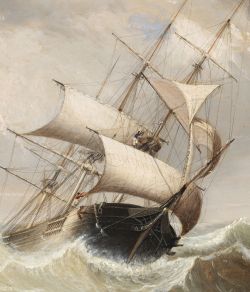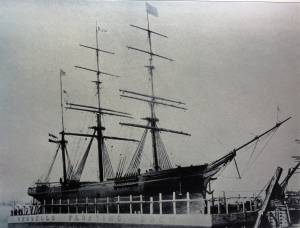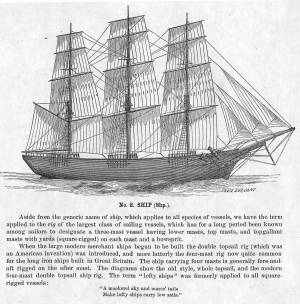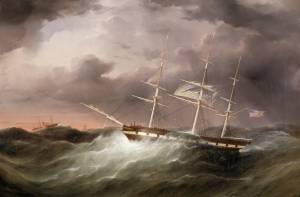An online project under the direction of the CAPE ANN MUSEUM
inv. 4
Three Master in Rough Seas
A Ship in a Stormy Sea; A Smart Blow
1856 Oil on canvas 10 1/2 x 15 3/4 in. (26.7 x 40 cm) Frame: H. 22 1/4 x 43.2 in. (56.5 cm) 17 Signed, dated, and inscribed verso: F.H. Lane 1856 A Smart Blow
|
Related Work in the Catalog
Supplementary Images
Explore catalog entries by keywords view all keywords »
Historical Materials
Below is historical information related to the Lane work above. To see complete information on a subject on the Historical Materials page, click on the subject name (in bold and underlined).
See figs. 458 and 459.
"In taking in a Topsail, Fig. 458, the Weather Sheet (f), is first clewed up, because the Sail naturally flies to leeward, and keeps full: then the Bowline (e), and lee Sheet (d), being let go, the Sail catches aback, like Figure 459, and is taken almost without a Shake; for if the lee Sheet were eased off first, the Sail might shake so violently as to split. However it is sometimes necessary when a Vessel is weakly manned, to haul the Clew-line a little up, in order to get the weather Brace in."
Reference:
Lever, The Young Sea Officer's Sheet Anchor or a Key to the Leading of Rigging and Practical Seamanship, 2nd ed. (1819), 86.
The term "ship," as used by nineteenth-century merchants and seamen, referred to a large three-masted sailing vessel which was square-rigged on all three masts. (1) In that same period, sailing warships of the largest classes were also called ships, or more formally, ships of the line, their size qualifying them to engage the enemy in a line of battle. (2) In the second half of the nineteenth century, as sailing vessels were replaced by engine-powered vessels, the term ship was applied to any large vessel, regardless of propulsion or use. (3)
Ships were often further defined by their specialized uses or modifications, clipper ships and packet ships being the most noted examples. Built for speed, clipper ships were employed in carrying high-value or perishable goods over long distances. (4) Lane painted formal portraits of clipper ships for their owners, as well as generic examples for his port paintings. (5)
Packet ships were designed for carrying capacity which required some sacrifice in speed while still being able to make scheduled passages within a reasonable time frame between regular destinations. In the packet trade with European ports, mail, passengers, and bulk cargos such as cotton, textiles, and farm produce made the eastward passages. Mail, passengers (usually in much larger numbers), and finished wares were the usual cargos for return trips. (6) Lane depicted these vessels in portraits for their owners, and in his port scenes of Boston and New York Harbors.
Ships in specific trades were often identified by their cargos: salt ships which brought salt to Gloucester for curing dried fish; tea clippers in the China Trade; coffee ships in the West Indies and South American trades, and cotton ships bringing cotton to mills in New England or to European ports. Some trades were identified by the special destination of a ship’s regular voyages; hence Gloucester vessels in the trade with Surinam were identified as Surinam ships (or barks, or brigs, depending on their rigs). In Lane’s Gloucester Harbor scenes, there are likely (though not identifiable) examples of Surinam ships, but only the ship "California" in his depiction of the Burnham marine railway in Gloucester (see Three Master on the Gloucester Railways, 1857 (inv. 29)) is so identified. (7)
– Erik Ronnberg
References:
1. R[ichard)] H[enry] Dana, Jr., The Seaman’s Friend, 13th ed. (Boston: Thomas Groom & Co., 1873), p. 121 and Plate IV with captions.
2. A Naval Encyclopaedia (Philadelphia: L. R. Hamersly & Co., 1884), 739, 741.
3. M.H. Parry, et al., Aak to Zumbra: A Dictionary of the World’s Watercraft (Newport News, VA: The Mariners’ Museum, 2000), 536.
4. Howard I. Chapelle, The History of American Sailing Ships (New York: W.W. Norton & Co., 1935), 281–87.
5. Ibid.
6. Howard I. Chapelle, The National Watercraft Collection (Washington, DC: Smithsonian Institution, 1960), 26–30.
7. Alfred Mansfield Brooks, Gloucester Recollected: A Familiar History (Gloucester, MA: Peter Smith, 1974), 67–69.
Photograph
From American Clipper Ships 1833–1858, by Octavius T. Howe and Frederick C. Matthews, vol. 1 (Salem, MA: Marine Research Society, 1926).
Photo caption reads: "'Golden State' 1363 tons, built at New York, in 1852. From a photograph showing her in dock at Quebec in 1884."
Also filed under: "Golden State" (Clipper Ship) »
Oil on canvas
24 x 35 in.
Peabody Essex Museum, Salem, Mass.
Walters' painting depicts the "Nonantum" homeward bound for Boston from Liverpool in 1842. The paddle-steamer is one of the four Clyde-built Britannia-class vessels, of which one is visible crossing in the opposite direction.
View related Fitz Henry Lane catalog entries (2) »
Also filed under: Packet Shipping » // Walters, Samuel »
It was usual practice to prime all ship’s ironwork with red lead, which has a dark brownish red color. This was usually all that was done for anchors, but other ironwork, like chain plates. hawse pipe liners, chocks, cleats, and the iron on deck machinery was given a finish color, such as black, white, and sometimes bright red or other color. Ironwork in spars was also red-leaded, then painted to match the spar color—white, black, or brown if oiled or varnished bright. Lane’s work pre-dates galvanized hardware.



_sm.jpg)





Commentary
Ships in distress have always been a favorite subject of marine painters. Besides the visual drama of the clouds, sea, and heaving ships, Lane's painting depicts a situation that could have ended in life or death. Shipwrecks were a very real terror to coastal people, particularly in Gloucester. Dozens of fishermen were lost every year: 162 men were lost in 1862 alone. In a town of only eight thousand people, these losses touched everyone’s life. A painting such as this must have triggered all those fears, yet it is also celebrating the capability of ships and their crews to weather such storms. One imagines a Yankee audience being far more drawn to a scene where skill and shipcraft survive a storm, rather than to the pathos of the common shipwreck painting where all hands are lost.
This is one of Lane’s finest paintings of the genre. Surprisingly small (only 10 x 16 inches), it is a highly detailed, flawlessly composed and painted story of a dramatic moment on a ship in a clearing storm. In the enlargement (below) one can see that the fore-topsail sheet has broken and the bottom is flying free. The starboard fore topsail sheet has parted and the loose corner of the sail is flogging wildly, certain to suffer serious damage if not furled quickly. Two crewmen have been sent aloft to assess the condition of the sail, which must be clewed up (lower corners hauled up to the yard) before they can go further. Out of sight on deck is most of the crew preparing to lower the topsail yard to the mast cap, clew up the topsail, haul up its buntlines, and trim the topsail yard, making the sail less difficult to furl. Then all hands will go aloft to furl the topsail, which will demand all their strength in a coordinated effort. Imagine a sail of several hundred pounds of wet canvas whipping about in a forty-plus-knot wind. The force of the sheet (rope) attached to a sail that is flapping in the wind could easily send a man flying to an instant death. The almost unimaginable feat of corraling and furling a sail in a gale on a wildly pitching ship was an everyday occurrence for seamen of the time.
Unlike the wild imaginings of novelists and land-locked romanticists, seamanship on a large square-rigger required discipline and coordinated actions of the highest order. Nothing was left to chance. Every sailor knew his job and understood his place in every task, for his life – and the lives of his shipmates – depended on it. Acutely conscious of this, Lane was careful in depicting a ship’s crew at sea. As the son of a sailmaker – one of the waterfront’s most respected class of artisans – he would have had rare access and insight to the vessels and the trades which built and operated them.
Lane’s mastery is on full display in this painting. In the enlargement below, note the extraordinary precision of the rigging. The fine, hair-thin lines represent entirely accurately how this ship would have been rigged. The masts and yard arms show all their proper variation in color and size; the sails show their weight and texture and the force of the wind. The hull is a dark monolith forging through the waves. One feels that it is at the edge of its equilibrium; it is a match for these seas, but only just. Lane has positioned the hull rising in the seas, setting the angle of the vessel’s pitch and its masts at a perfect diagonal. One anticipates how the bow will come crashing down and how the hull will pitch in the opposite direction as it takes the next wave.
This is a dynamic composition that Lane has further focused by framing it with the dark shadows of the waves on the lower left and right, mirrored by the dark clouds in the upper left and right. The sky has some soft pink in the clearing center and on the horizon. The overall palette is green, dark umber, and pink: a deceptively simple and sophisticated color scheme.
– Sam Holdsworth, Erik Ronnberg
[+] See More